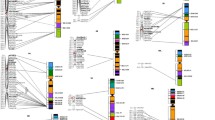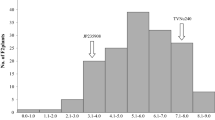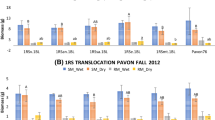Abstract
The teosinte Zea nicaraguensis, a wild relative of maize, possesses a flooding tolerance-related trait: the formation of constitutive root aerenchyma under drained (non-flooded) soil conditions. A previous study suggested that the degree of constitutive aerenchyma formation varies within Z. nicaraguensis. The objectives of this study were to construct linkage maps, to determine the marker order in a region of chromosome 4 in which recombination between maize and Z. nicaraguensis is suppressed, and to identify quantitative trait loci (QTL) controlling constitutive root aerenchyma formation in two segregating populations of Z. nicaraguensis. A total of 236 simple sequence repeat (SSR) markers were screened for polymorphism in an S1 population of Z. nicaraguensis. Seventy-one polymorphic SSR markers were assigned to 10 chromosomes, and a linkage map was constructed covering 793.5 cM. In the S1 map, a paracentric inversion was detected on the long arm of chromosome 4; this rearrangement was confirmed in an S1 linkage map of a different Z. nicaraguensis accession. Composite interval mapping analysis in 96 S1 plants revealed QTL for aerenchyma formation on chromosomes 1 (bins 1.06–1.07) and 7 (bin 7.01), explaining 17 and 12% of the total phenotypic variance, respectively. The QTL on chromosome 1 was verified by using 156 S2 plants. Near-isogenic lines exhibiting the presence or absence of the aerenchyma QTL have been developed that should be useful for genetic and physiological analyses of root aerenchyma formation.




Similar content being viewed by others
References
Bird RMcK (2000) A remarkable new teosinte from Nicaragua: Growth and treatment of progeny. Maize Gen Coop Newsl 74:58–59
Bouranis DL, Chorianopoulou SN, Kollias C, Maniou P, Protonotarios VE, Siyiannis VF, Hawkesford MJ (2006) Dynamics of aerenchyma distribution in the cortex of sulfate-deprived adventitious roots of maize. Ann Bot 97:695–704
Colmer TD (2003) Aerenchyma and an inducible barrier to radial oxygen loss facilitate root aeration in upland, paddy and deep-water rice (Oryza sativa L.). Ann Bot 91:301–309
Doebley J, Stec A (1991) Genetic analysis of the morphological differences between maize and teosinte. Genetics 129:285–295
Doebley J, Stec A (1993) Inheritance of the morphological differences between maize and teosinte: comparison of results for two F2 populations. Genetics 134:559–570
Drew MC, He CJ, Morgan PW (2000) Programmed cell death and aerenchyma formation in roots. Trends Plant Sci 5:123–127
Fan M, Zhu J, Richards C, Brown KM, Lynch JP (2003) Physiological roles for aerenchyma in phosphorus-stressed roots. Func Plant Biol 30:493–506
Fukunaga K, Hill J, Vigouroux Y, Matsuoka Y, Sanchez GJ, Liu K, Buckler ES, Doebley J (2005) Genetic diversity and population structure of teosinte. Genetics 169:2241–2254
Garthwaite AJ, von Bothmer R, Colmer TD (2003) Diversity in root aeration traits associated with waterlogging tolerance in the genus Hordeum. Func Plant Biol 30:875–889
Haldane JBS (1919) The combination of linkage values and the calculation of distance between the loci of linked factors. J Genet 8:299–309
He CJ, Finlayson SA, Drew MC, Jordan WR, Morgan PW (1996) Ethylene biosynthesis during aerenchyma formation in roots of maize subjected to mechanical impedance and hypoxia. Plant Physiol 112:1679–1685
Hochholdinger F (2009) The maize root system: morphology, anatomy and genetics. In: Bennetzen JL, Hake SC (eds) Handbook of maize: its biology. Springer, New York, pp 145–160
Hochholdinger F, Tuberosa R (2009) Genetic and genomic dissection of maize root development and architecture. Curr Opin Plant Biol 12:172–177
Hoffmann AA, Sgrò CM, Weeks AR (2004) Chromosomal inversion polymorphisms and adaptation. Trends Ecol Evol 19:482–488
Iltis HH, Benz BF (2000) Zea nicaraguensis (Poaceae), a new teosinte from Pacific coastal Nicaragua. Novon 10:382–390
Iltis HH, Doebley JF (1980) Taxonomy of Zea (Gramineae). II. Subspecific categories in the Zea mays complex and a generic synopsis. Am J Bot 67:994–1004
Jackson MB, Armstrong W (1999) Formation of aerenchyma and the processes of plant ventilation in relation to soil flooding and submergence. Plant Biol 1:274–287
Jackson MB, Fenning TM, Jenkins W (1985) Aerenchyma (gas-space) formation in adventitious roots of rice (Oryza sativa L.) is not controlled by ethylene or small partial pressures of oxygen. J Exp Bot 36:1566–1572
Komatsuda T, Nakamura I, Takaiwa F, Oka S (1998) Development of STS markers closely linked to the vrs1 locus in barley, Hordeum vulgare. Genome 41:680–685
Lander ES, Green P, Abrahamson J, Barlow A, Daly MJ, Lincoln SE, Newburg L (1987) MAPMAKER: an interactive computer package for constructing primary genetic linkage maps of experimental and natural populations. Genomics 1:174–181
Lynch JP (2007) Roots of the second green revolution. Aust J Bot 55:493–512
Mano Y, Omori F (2007) Breeding for flooding tolerant maize using “teosinte” as a germplasm resource. Plant Root 1:17–21
Mano Y, Omori F (2008) Verification of QTL controlling root aerenchyma formation in a maize × teosinte “Zea nicaraguensis” advanced backcross population. Breed Sci 58:217–223
Mano Y, Omori F (2009) High-density linkage map around the root aerenchyma locus Qaer1.06 in the backcross populations of maize Mi29 × teosinte “Zea nicaraguensis”. Breed Sci 59:427–433
Mano Y, Muraki M, Fujimori M, Takamizo T, Kindiger B (2005) AFLP-SSR maps of maize × teosinte and maize × maize: comparison of map length and segregation distortion. Plant Breed 124:432–439
Mano Y, Omori F, Takamizo T, Kindiger B, RMcK Bird, Loaisiga CH, Takahashi H (2007) QTL mapping of root aerenchyma formation in seedlings of a maize × rare teosinte “Zea nicaraguensis” cross. Plant Soil 295:103–113
Mano Y, Omori F, Kindiger B, Takahashi H (2008) A linkage map of maize × teosinte Zea luxurians and identification of QTLs controlling root aerenchyma formation. Mol Breed 21:327–337
Omori F, Mano Y (2007) QTL mapping of root angle in F2 populations from maize ‘B73’ × teosinte ‘Zea luxurians’. Plant Root 1:57–65
Ray JD, Kindiger B, Dewald CL, Sinclair TR (1998) Preliminary survey of root aerenchyma in Tripsacum. Maydica 43:49–53
Scanlon MJ, Chen KD, McKnight CC (2000) The narrow sheath duplicate genes: Sectors of dual aneuploidy reveal ancestrally conserved gene functions during maize leaf development. Genetics 155:1379–1389
Sharopova N, McMullen MD, Schultz L, Schroeder S, Sanchez-Villeda H, Gardiner J, Bergstrom D, Houchins K, Melia-Hancock S, Musket T, Duru N, Polacco M, Edwards K, Ruff T, Register JC, Brouwer C, Thompson R, Velasco R, Chin E, Lee M, Woodman-Clikeman W, Long MJ, Liscum E, Cone K, Davis G, Coe EH (2002) Development and mapping of SSR markers for maize. Plant Mol Biol 48:463–481
Stuber CW, Edwards MD, Wendel JF (1987) Molecular marker-facilitated investigations of quantitative trait loci in maize. II. Factors influencing yield and its component traits. Crop Sci 27:639–648
Tuberosa R, Salvi S, Sanguineti MC, Maccaferri M, Giuliani S, Landi P (2003) Searching for quantitative trait loci controlling root traits in maize: a critical appraisal. Plant Soil 255:35–54
Wang S, Basten CJ, Zeng Z-B (2006) Windows QTL cartographer 2.5. Department of Statistics, North Carolina State University, Raleigh. http://statgen.ncsu.edu/qtlcart/WQTLCart.htm
Westerbergh A, Doebley J (2002) Morphological traits defining species differences in wild relatives of maize are controlled by multiple quantitative trait loci. Evolution 56:273–283
Whitkus R, Doebley J, Lee M (1992) Comparative genome mapping of sorghum and maize. Genetics 132:1119–1130
Zhu J, Brown K, Lynch J (2010) Root cortical aerenchyma improves the drought tolerance of maize (Zea mays L.). Plant Cell Environ 33:740–749
Acknowledgments
The authors wish to thank the North Central Regional Plant Introduction Station (NCRPIS), USDA-ARS/Iowa State University, Ames, Iowa, USA, for providing seed of Z. nicaraguensis (PI 615697); the International Maize and Wheat Improvement Center (CIMMYT), Mexico, for supplying seed of Z. nicaraguensis (CIMMYT 13451); and the National Agricultural Research Center for Kyushu Okinawa Region for providing maize inbred Mi29. We also thank Dr. B. Kindiger (USDA/ARS) for critically reviewing the manuscript, and Dr. R. McK. Bird (North Carolina State University), Dr. H. Takahashi (Akita Prefectural University), and Dr. C. H. Loaisiga (Universidad Nacional Agraria) for contributing to the work. This work was supported by grants from Sapporo Bioscience Foundation, the Bio-oriented Technology Research Advancement Institution (Promotion of Basic Research Activities for Innovative Biosciences, No. H20/seeds-01-02), and the Ministry of Agriculture, Forestry and Fisheries of Japan (Genomics for Agricultural Innovation, FBW1101).
Author information
Authors and Affiliations
Corresponding author
Rights and permissions
About this article
Cite this article
Mano, Y., Omori, F. & Takeda, K. Construction of intraspecific linkage maps, detection of a chromosome inversion, and mapping of QTL for constitutive root aerenchyma formation in the teosinte Zea nicaraguensis . Mol Breeding 29, 137–146 (2012). https://doi.org/10.1007/s11032-010-9532-z
Received:
Accepted:
Published:
Issue Date:
DOI: https://doi.org/10.1007/s11032-010-9532-z




